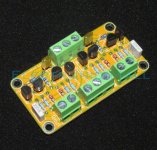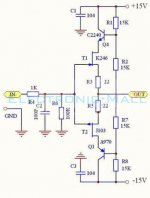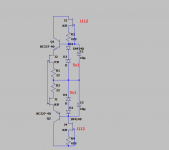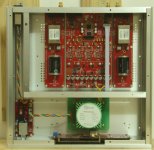I have an ICEpower 50ASX2 which is sounding good, but I want to try adding a buffer.
I bought a cheap jfet buffer board which is found all over eBay and AliExpress for $10 or so.
It uses 1x C2240, K246, J103, and A970 per channel.
If I use a good power supply such as an LT3045/LT3094, will this buffer do the ICEpower justice?
Alternatively, I just found an unfinished buffer PCB in my collection - the Joachim Gerhard buffer -
https://www.diyaudio.com/forums/group-buys/216669-joachim-gerhard-filter-buffer-es9022.html
This uses 2x BF862 and 2x MMBFJ309 per channel.
My only hesitation with this board is the need to solder 12x tiny SMD resistors!
I bought a cheap jfet buffer board which is found all over eBay and AliExpress for $10 or so.
It uses 1x C2240, K246, J103, and A970 per channel.
If I use a good power supply such as an LT3045/LT3094, will this buffer do the ICEpower justice?
Alternatively, I just found an unfinished buffer PCB in my collection - the Joachim Gerhard buffer -
https://www.diyaudio.com/forums/group-buys/216669-joachim-gerhard-filter-buffer-es9022.html
This uses 2x BF862 and 2x MMBFJ309 per channel.
My only hesitation with this board is the need to solder 12x tiny SMD resistors!
Attachments
Looks perfect.
Especially if you trust the seller that the semis are original. I wouldn't but that's just me 🙂
And those screws would better go. They may be acceptable for the power lines but i'd never use them for signal.
Especially if you trust the seller that the semis are original. I wouldn't but that's just me 🙂
And those screws would better go. They may be acceptable for the power lines but i'd never use them for signal.
Those are good connectors when one replaces them for Phoenix ones that are copper/brass. The Phoenix ones are excellent for signal as well and way better than soldering wires to boards.
I think they used so-called "pulled" JFETs but if they are original it is a bargain. For that price an acceptable gamble. Why not connect it and try it out?
Soldering 12 SMD resistors is what separates the men from the boys 🙂
I have the 50ASX2SE as well. An unexpected good performer (I thought it could not compete with other amps I have) connected directly to a DCB1. It is the varying input impedance that created the (more or less) urban myth that 50ASX2 needs a buffer but if your pre is capable there is no need for a buffer at all. Connecting a volume potentiometer directly to 50ASX2 is not OK.
So yes, when you have tested it is not detrimental to the sound and no channel differences can be heard/measured and that PSU is used. If it is needed is another question.
I think they used so-called "pulled" JFETs but if they are original it is a bargain. For that price an acceptable gamble. Why not connect it and try it out?
Soldering 12 SMD resistors is what separates the men from the boys 🙂
I have the 50ASX2SE as well. An unexpected good performer (I thought it could not compete with other amps I have) connected directly to a DCB1. It is the varying input impedance that created the (more or less) urban myth that 50ASX2 needs a buffer but if your pre is capable there is no need for a buffer at all. Connecting a volume potentiometer directly to 50ASX2 is not OK.
If I use a good power supply such as an LT3045/LT3094, will this buffer do the ICEpower justice?
So yes, when you have tested it is not detrimental to the sound and no channel differences can be heard/measured and that PSU is used. If it is needed is another question.
Last edited:
What is the purpose of an input buffer? There is already one on the normal board. With 8k minimum input impedance it can be driven fron any CD-player, preamp or mixer.
Those are good connectors when one replaces them
This is true for most connectors 😀
🙂 the Chinese nearly always fail the magnet test. Not only the screws are iron (OK) but also the contacts....
Of course I meant that screw connectors of a respectable brand are OK for signal. The system itself is OK as a connection in audio but only if they are made from copper/brass.
Geezer warning: like SMPS are replacing linear PSU's is copper/brass being replaced for recycled stuff (so so) or even worse steel or the very worst "anymetal"... I was crimping connectors last week and found my tool had some problem crimping the connector only to find out even the connector was made of steel.
Of course I meant that screw connectors of a respectable brand are OK for signal. The system itself is OK as a connection in audio but only if they are made from copper/brass.
Geezer warning: like SMPS are replacing linear PSU's is copper/brass being replaced for recycled stuff (so so) or even worse steel or the very worst "anymetal"... I was crimping connectors last week and found my tool had some problem crimping the connector only to find out even the connector was made of steel.
Attachments
Last edited:
Sure, I had read many reports that a buffer or preamp is necessary with the lower power ICE amps, and while this may, or may not be true, my DAC has a transformer output stage and the designer of this output stage advises that it performs best when it sees a minimum input impedance of 20k, and preferably higher.
I must say that the amp sounds damn good as-is, though maybe with a small hint of "raggedness" in the top end.
The designer has a workaround for such situations where input impedance is lower - add a snubber circuit to the transformer secondaries - and I will try this later, but I will try a buffer first.
And OK, I will go with the JG buffer, once I skill up with SMD soldering.
I must say that the amp sounds damn good as-is, though maybe with a small hint of "raggedness" in the top end.
The designer has a workaround for such situations where input impedance is lower - add a snubber circuit to the transformer secondaries - and I will try this later, but I will try a buffer first.
And OK, I will go with the JG buffer, once I skill up with SMD soldering.
I had a closer look at the circuit in the OP and I doubt it will have a positive effect.
1. Any disturbance of the power rails will appear on the drains of the Fets almost unfiltered (can be fixed with 2 Cs additionally)
2. Output impedance is pretty high (160 ohm at 5mA Idss) and varies with the output level and frequency.
3. The Fets need to be selected for equal Idss, the parts have a 10:1 variation each.
4. Offset will vary with time and temperature.
5. Input spikes > +/-7V destroy the Fets
6. Additional distortion is created.by the fets
1. Any disturbance of the power rails will appear on the drains of the Fets almost unfiltered (can be fixed with 2 Cs additionally)
2. Output impedance is pretty high (160 ohm at 5mA Idss) and varies with the output level and frequency.
3. The Fets need to be selected for equal Idss, the parts have a 10:1 variation each.
4. Offset will vary with time and temperature.
5. Input spikes > +/-7V destroy the Fets
6. Additional distortion is created.by the fets
Please don't look at Pass designs then 🙂
It needs coupling caps at the outputs indeed but 50ASX2 already has input caps AFAIK (please check!).
It needs coupling caps at the outputs indeed but 50ASX2 already has input caps AFAIK (please check!).
Last edited:
So you had a flawlessly performing DAC, added a completely unnecessary output transformer 🙄 , and now have to add a normally unnecessary buffer to correct the problems caused by the transformer. 🙄my DAC has a transformer output stage and the designer of this output stage advises that it performs best when it sees a minimum input impedance of 20k, and preferably higher.
Why, oh why?

I don't know if output transformers causes problems. I like them a lot instead of opamps. They may not be ideal (nothing is) but they sure filter and have galvanic separation as effect. Many DACs with output transformers are liked by people that listen with their ears. Having extensively compared I would choose for transformers anytime.
@ linuxfan: the issue is clear and you indeed need a buffer when driving the 50ASX2 with a transformer output DAC that likes to see 20 kOhm or higher loads. Please check if the 50ASX2 has input caps. Then you can omit output caps for the buffer. If you don't have many sources OR other sources that are perfectly capable of driving the 50ASX2 you could add the buffer to the DAC as it is the DAC that needs it, nothing else. It saves from having an extra component in the chain. In general less is more.
@ linuxfan: the issue is clear and you indeed need a buffer when driving the 50ASX2 with a transformer output DAC that likes to see 20 kOhm or higher loads. Please check if the 50ASX2 has input caps. Then you can omit output caps for the buffer. If you don't have many sources OR other sources that are perfectly capable of driving the 50ASX2 you could add the buffer to the DAC as it is the DAC that needs it, nothing else. It saves from having an extra component in the chain. In general less is more.
Last edited:
R2, R7 should better be connected to the output pinI have an ICEpower 50ASX2 which is sounding good, but I want to try adding a buffer.
I bought a cheap jfet buffer board which is found all over eBay and AliExpress for $10 or so.
It uses 1x C2240, K246, J103, and A970 per channel.
If I use a good power supply such as an LT3045/LT3094, will this buffer do the ICEpower justice?
Alternatively, I just found an unfinished buffer PCB in my collection - the Joachim Gerhard buffer -
Joachim Gerhard Filter Buffer for ES9022
This uses 2x BF862 and 2x MMBFJ309 per channel.
My only hesitation with this board is the need to solder 12x tiny SMD resistors!
This would be a littele bit better.The zenner diodes could be anything up to 7.5v, 5v1/400mw has the lowest tempco according to two major zenner manufacturers. R3, R4 could be anything in between 470ohm ...1kohm
Attachments
It's a bad idea to make broad assumptions.So you had a flawlessly performing DAC, added a completely unnecessary output transformer
I never said anything about "adding" an output transformer. It's an integral part of the HQ-Audio ES9018 DAC.
Attachments
Do you mean the schematic? It's here -for some reason i can'tr find original Gerhardt buffers in the links provided.
https://www.diyaudio.com/forums/gro...hard-filter-buffer-es9022-31.html#post3288434
- Home
- Source & Line
- Analog Line Level
- Is this cheap jfet buffer any good?




